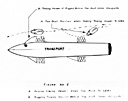
Chapter VIII
Rubber Boat Operations
Index
| Section 1. | General |
| Section 2. | General Description of Types |
| Section 3. | Stowage, Inflation, Launching and Loading |
| Section 4. | Landing |
| Section 5. | Training |
| Section 6. | Manufacturer's Notes on Ten-Man Rubber Boat [not included] |
Section 1. General
- Rubber boat operations differ from normal landing operations in that they are of a specialized nature and require a special technique for their accomplishment. It is the purpose of this chapter to describe the technique of rubber boat operations in order to assist in the training of troops and ships in this particular type of landing.
- At present, troops executing ship to shore movements in rubber boats are embarked on APs, AKs, SSs, and APDs. In addition to APDs it is contemplated that, in the future, DDs and DEs will also be used as high speed troop transports, utilizing rubber boats in the ship to shore movement.
-
When the success of the mission depends upon secrecy
and/or tactical surprise, rubber boats are nearly always
employed. Such special missions may be one or more of
the following:
- To land and reembark troops under cover of darkness in order to gain or verify information of the enemy, to capture prisoners, etc.
- To land troops under cover of darkness in order to capture an atoll or seize a beach-head pending the arrival of supporting troops.
- To land troops during daylight or under cover of darkness in order to attack the hostile flank or rear.
- To land reserves through surf on a beach-head under friendly control in order to exploit success or further the attack.
- To execute hit and run raids in order to damage hostile installations, dumps, etc.
- To take demolition teams near a hostile beach to destroy underwater obstacles.

